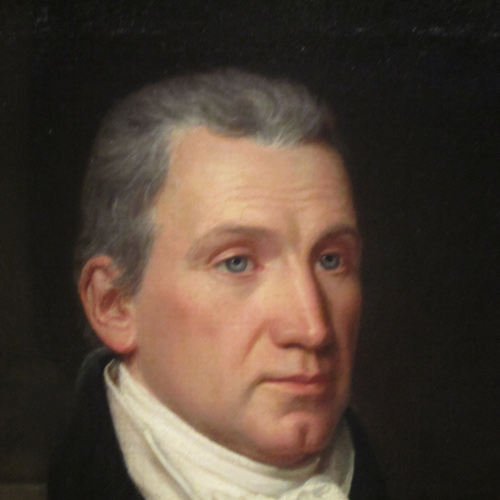In Washington City, President Jefferson writes a letter of credence to Napoleon Bonaparte granting the powers of a full ambassador to James Monroe and Robert Livingston. The two would negotiate what became known as the Louisiana Purchase.
James Monroe (c. 1832, detail)
by William James Hubbard
Photo by Billy Hathorn at National Portrait Gallery who has made it available under the Creative Commons CC0 1.0 Universal Public Domain Dedication.
James Monroe was a generation younger than almost all the Founding Fathers he was working with including his negotiating partner Robert Livingston.
Letter of Credence
Citizen First-Consul
Desirous of improving and perpetuating, by every arrangement calculated for mutual advantage, the good correspondence which so happily prevails between the united States and the French Republic, I have for this purpose, with the advice and consent of the Senate, given full powers to Robert R. Livingston, now our Minister Plenipotentiary at Paris, and to James Monroe, lately Governor of the State of Virginia, who repairs thither in the character of Minister Extraordinary and Plenipotentiary.
I beseech you, therefore, to give full credence to whatever they shall say to you on the part of the United States, and most of all when they shall assure you of our friendship and wishes for the prosperity of France. And I pray God, to have you, Citizen First Consul, in his safe and holy keeping.
Th: Jefferson[1]Thomas Jefferson to Napoleon Bonaparte” Founders Online, National Archives, founders.archives.gov/documents/Jefferson/01-39-02-0430 accessed 15 May 2022. [Original source: The Papers of Thomas … Continue reading
Trading Houses Act
The bill to revive an act, entitled “An act for establishing trading-houses with the Indian tribes,” was read the second time, and ordered to the third reading.
Notes
| ↑1 | Thomas Jefferson to Napoleon Bonaparte” Founders Online, National Archives, founders.archives.gov/documents/Jefferson/01-39-02-0430 accessed 15 May 2022. [Original source: The Papers of Thomas Jefferson, vol. 39, 13 November 1802–3 March 1803, ed. Barbara B. Oberg. Princeton: Princeton University Press, 2012, pp. 498–499.] |
|---|
Experience the Lewis and Clark Trail
The Lewis and Clark Trail Experience—our sister site at lewisandclark.travel—connects the world to people and places on the Lewis and Clark Trail.
Discover More
- The Lewis and Clark Expedition: Day by Day by Gary E. Moulton (University of Nebraska Press, 2018). The story in prose, 14 May 1804–23 September 1806.
- The Lewis and Clark Journals: An American Epic of Discovery (abridged) by Gary E. Moulton (University of Nebraska Press, 2003). Selected journal excerpts, 14 May 1804–23 September 1806.
- The Lewis and Clark Journals. by Gary E. Moulton (University of Nebraska Press, 1983–2001). The complete story in 13 volumes.


